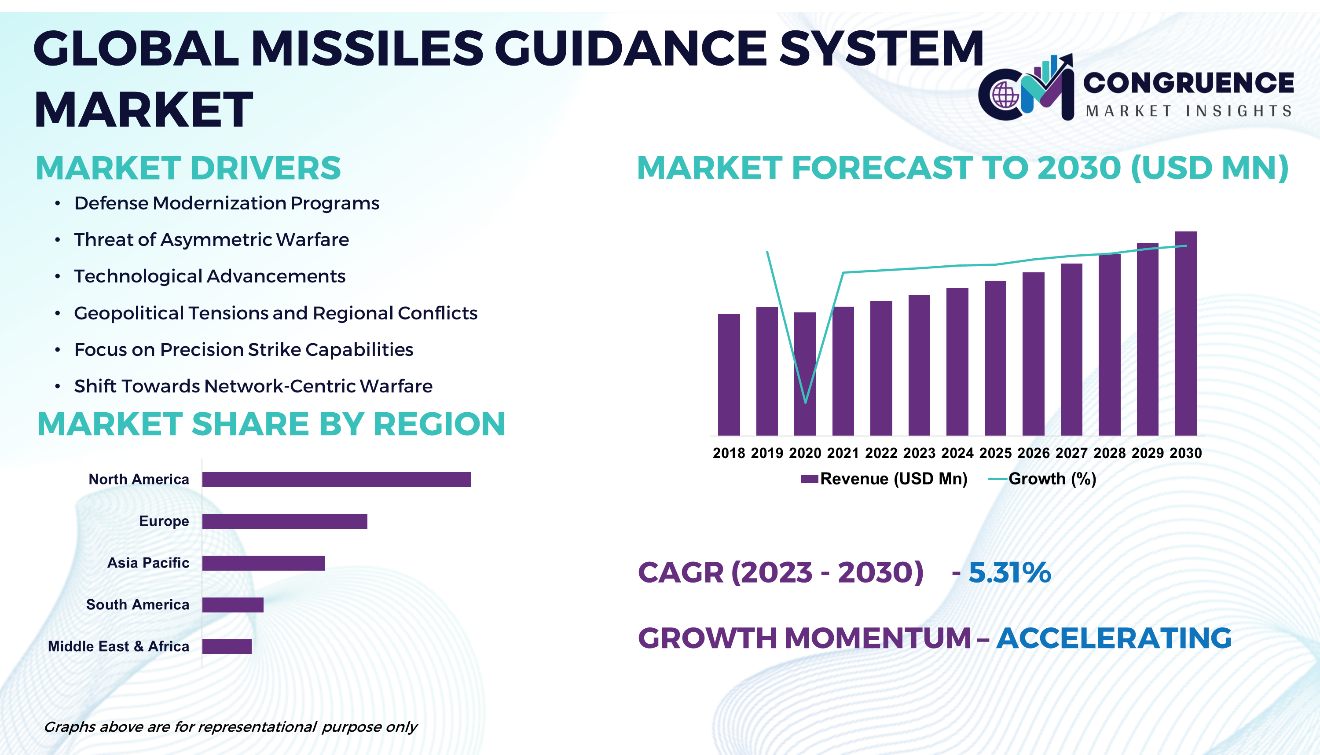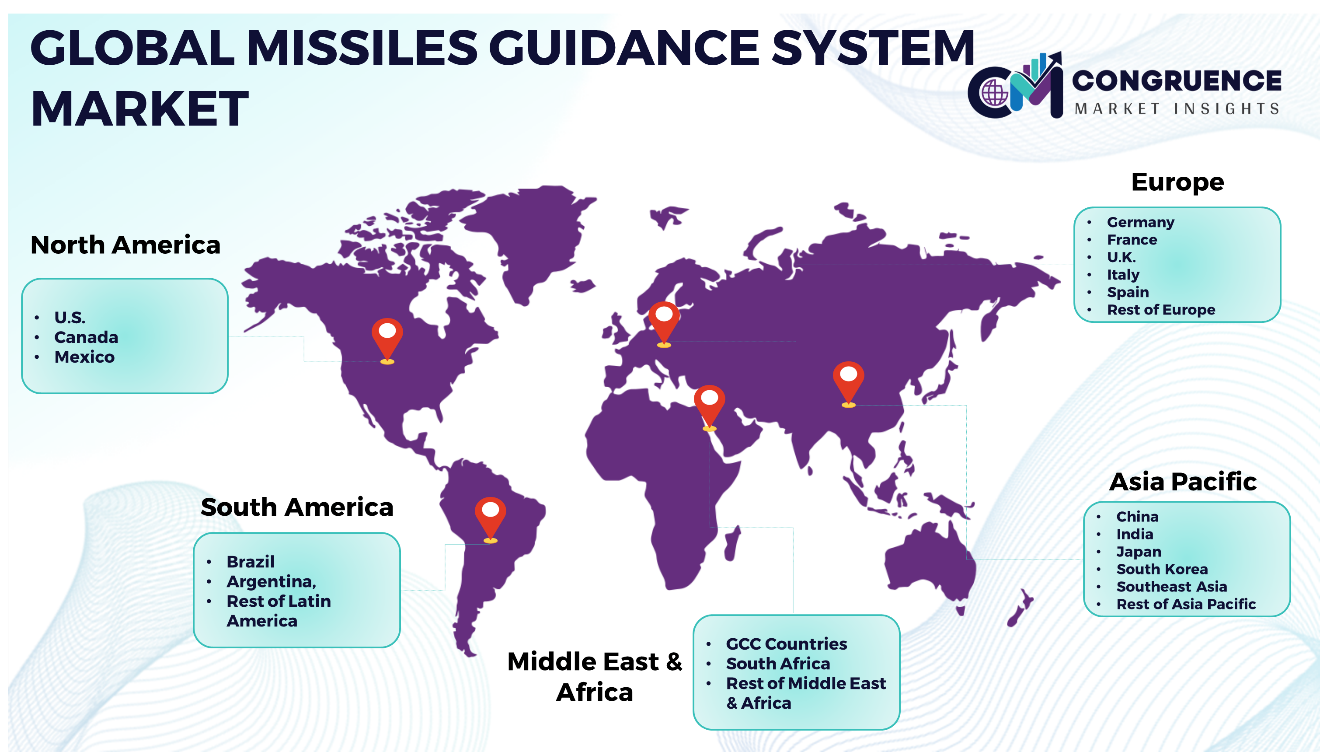Reports
The Global Missile Guidance System Market is expected to expand at a CAGR of 5.31% between 2023 and 2030. The global missile guidance system market has experienced notable expansion in recent years, propelled by escalating defense expenditures, geopolitical complexities, and technological advancements in missile technology. The market landscape is characterized by robust competition among leading industry participants, each dedicated to continual innovation and improvement of their product offerings. Technological progressions within missile guidance systems have yielded more precise, dependable, and adaptable guidance solutions, encompassing inertial navigation, GPS, radar, and laser guidance systems. Moreover, the integration of artificial intelligence, machine learning, and autonomous functionalities is reshaping the trajectory of missile guidance, empowering the development of intelligent and responsive missile systems to address evolving defense imperatives.

Missile Guidance System Market Major Driving Forces
Defense Modernization Programs: Increasing defense budgets worldwide, particularly in emerging economies and regions with geopolitical tensions, drive the demand for advanced missile guidance systems to modernize military capabilities.
Threat of Asymmetric Warfare: The evolving nature of modern warfare, including the proliferation of asymmetric threats such as terrorism and insurgency, necessitates the development of more sophisticated and precise missile guidance systems to counter diverse threats effectively.
Technological Advancements: Rapid advancements in sensor technology, signal processing, artificial intelligence, and miniaturization enable the development of more accurate, reliable, and versatile missile guidance systems with enhanced capabilities and performance.
Geopolitical Tensions and Regional Conflicts: Heightened geopolitical tensions, territorial disputes, and regional conflicts drive the demand for missile guidance systems as countries seek to bolster their defense capabilities and deter potential adversaries.
Focus on Precision Strike Capabilities: The increasing emphasis on precision strike capabilities, including the ability to target specific military assets, critical infrastructure, and high-value targets with minimal collateral damage, fuels the demand for advanced missile guidance systems.
Shift Towards Network-Centric Warfare: The adoption of network-centric warfare concepts, which emphasize enhanced situational awareness, interoperability, and real-time information sharing among military forces, drives the integration of advanced missile guidance systems into networked defense architectures.
Missile Guidance System Market Key Opportunities
Interoperability and Integration: Opportunities abound for the creation of interoperable missile guidance systems capable of seamless integration with existing defense platforms, command and control systems, and networked architectures, thereby facilitating improved joint and coalition operations.
Counter-UAS Systems: Given the proliferation of unmanned aerial systems (UAS) and drones, there is a growing need for missile guidance systems adept at detecting, tracking, and neutralizing hostile UAS threats, thereby offering opportunities for the development of dedicated counter-UAS systems.
Directed Energy Weapons (DEW): The development of directed energy weapons, including lasers and high-powered microwaves, presents prospects for integrating advanced missile guidance systems with DEW technologies to enable rapid and precise engagement of threats.
Hypersonic Missile Defense: The emergence of hypersonic missile threats presents opportunities for the advancement of missile guidance systems capable of tracking and intercepting hypersonic missiles, thereby bolstering missile defense capabilities.
Missile Guidance System Market Key Trends
· Advancements in sensor tech enhance accuracy and dependability of missile guidance systems, enabling effective target tracking and engagement.
· Integration of AI/ML optimizes system performance, allowing autonomous target engagement.
· Miniaturization enables integration into smaller missiles, improving maneuverability.
· Multi-mode systems blend guidance technologies for enhanced effectiveness.
· Enhanced system capabilities improve lethality and survivability.
· Digitalization enables real-time data exchange, enhancing situational awareness.
· Modular architectures allow for customization and swift upgrades.
· Interoperability facilitates integration with other defense systems.
· Cybersecurity ensures data integrity and protection against threats.

Market Competition Landscape
In the realm of missile guidance systems, the competitive arena is defined by robust competition among leading industry contenders, each striving to attain technological preeminence and market prominence. These entities employ strategic initiatives focused on innovation, product differentiation, and reliability to secure advantageous contracts and cultivate strategic alliances. The ongoing evolution of sensor technology and the incorporation of artificial intelligence serve as primary catalysts driving competition, with a concerted emphasis placed on enhancing the precision, efficiency, and adaptability of guidance systems.
Key players in the global Missile Guidance System market implement various organic and inorganic strategies to strengthen and improve their market positioning. Prominent players in the market include:
· Lockheed Martin Corporation
· RTX
· MBDA
· Boeing
· Northrop Grumman
· Mitsubishi Electric Corporation
· Serco Group Plc
· Kratos Defense & Security Solutions, Inc.
· BAE Systems
· Hanwha Group
· Kongsberg Defence & Aerospace
· Thales
· Rafael Advanced Defense Systems Ltd.
· Saab AB
· Leonardo S.p.A.
· IAI
· Rheinmetall AG
· General Dynamics Mission Systems, Inc.
· L3Harris Technologies, Inc.
|
Report Attribute/Metric |
Details |
|
Base Year |
2022 |
|
Forecast Period |
2023 – 2030 |
|
Historical Data |
2018 to 2022 |
|
Forecast Unit |
Value (US$ Mn) |
|
Key Report Deliverable |
Revenue Forecast, Growth Trends, Market Dynamics, Segmental Overview, Regional and Country-wise Analysis, Competition Landscape |
|
Segments Covered |
· By Platform Type (Airborne, Land-Based, and Naval) · By Component (Hardware, and Software) · By Technology (Inertial Navigation, GPS, Radar, and Others) · By Application (Surface-to-Air Missiles (SAMs), Air-to-Air Missiles (AAMs), Anti-Ship Missile (ASMs), Space Exploration, Homeland Security, and Others) · By End User (Government, and Aerospace and Defense) |
|
Geographies Covered |
North America: U.S., Canada and Mexico Europe: Germany, France, U.K., Italy, Spain, and Rest of Europe Asia Pacific: China, India, Japan, South Korea, Southeast Asia, and Rest of Asia Pacific South America: Brazil, Argentina, and Rest of Latin America Middle East & Africa: GCC Countries, South Africa, and Rest of Middle East & Africa |
|
Key Players Analyzed |
Lockheed Martin Corporation, RTX, MBDA, Boeing, Northrop Grumman, Mitsubishi Electric Corporation, Serco Group Plc, Kratos Defense & Security Solutions, Inc., BAE Systems, Hanwha Group, Kongsberg Defence & Aerospace, Thales, Rafael Advanced Defense Systems Ltd., Saab AB, Leonardo S.p.A., IAI, Rheinmetall AG, General Dynamics Mission Systems, Inc., and L3Harris Technologies, Inc. |
|
Customization & Pricing |
Available on Request (10% Customization is Free) |
